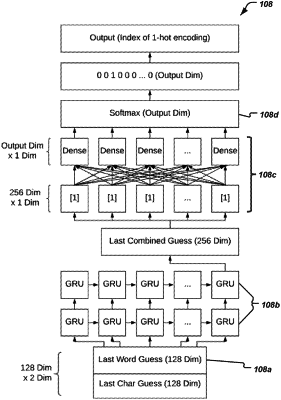| CPC G06N 3/04 (2013.01) [G06N 3/045 (2023.01); G06N 3/08 (2013.01); G06N 20/00 (2019.01); G06N 20/10 (2019.01); G06N 20/20 (2019.01); G06N 3/084 (2013.01)] | 20 Claims |

|
8. A system comprising:
one or more processors; and
one or more memories storing instructions that, when executed by the one or more processors, cause the system to perform a process of training an auto-suggest model of recurrent neural networks, the process comprising:
receiving an input from a user via a user device;
obtaining a combined vector based on concatenating of a first vector and a second vector associated with the input,
wherein the first vector indicates a predicted next character to follow the input based on a string of characters in the input, and
wherein the second vector indicates a predicted next word to follow the input based on one or more words in the input;
inputting, via the auto-suggest model, the combined vector into at least one mathematical function to generate an output,
wherein the output includes an index value that indicates a location of an output solution for the input in a predetermined array of solutions;
selecting the output solution located at the index value, wherein the output solution includes a prediction of information requested via the user device;
sending the output solution to the user device;
receiving a response from the user device based on the output solution,
wherein the response indicates the user either selected the output solution or did not select the output solution; and
training the auto-suggest model by adjusting location sequencing of output solutions to the input based on the response from the user.
|